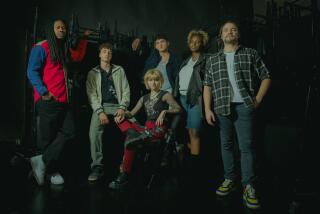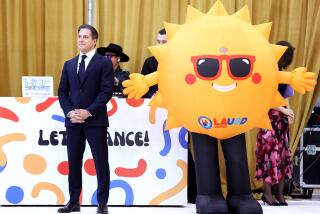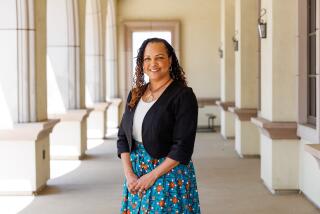Computer Class for the Deaf Gives Students Tools for Success
One group of students stood out Monday at the West Valley Occupational Center.
It wasnât that they were deaf and talked in sign language. There are hundreds of deaf students at the Los Angeles Unified School District job training center on Winnetka Avenue. What set these students apart as they walked to class or talked in the hallways was that they didnât look like students. They looked like the people who work down the street in the Warner Center, an office complex in Woodland Hills.
Required dress in the class was coats and ties for men, suits or office wear for women.
On the first day of class, last February, instructor Rich Miller laid down a few rules for the 23 students who enrolled in an unusual class in computer programming.
âJob Starts Nowâ
âThe job starts now,â Miller told them. âClass starts at 8, just like the job.â
In the 10 months of daily classes, from 8 a.m. to 4:30 p.m., they learned no academic theory. Instead, they were taught how to use the kind of tools that people in suits and neckties use--computer languages called COBOL, TSO/ISPF and JCL.
Eighteen of those students made it through the 1,200 hours of instruction that ended last week. They are believed to be the first crop of students anywhere to be trained specifically for a new computer career called program maintenance. Usually, computer programming classes teach how to write computer programs. This one taught how to change and modify old ones to keep the programs working for companies whose needs are changing.
The unusual combination of a class for deaf students in an experimental job field was the inspiration of a handful of people in private industry, particularly Joel Brust, president of Amtec Systems Corp. of West Los Angeles, said James R. Wall, director of the Occupational Center.
Brust, whose daughter is deaf, said he was checking out the school for classes that his daughter might take and noticed that there were no computer classes for the deaf.
May Be âPerfectly Equippedâ
He reasoned that computer program maintenance, which is destined to make up a growing part of the computer programming field, might be just the thing for the deaf.
âThe reality is these people may not be handicapped at all,â Brust said. âThey may be perfectly equipped to be programmers.â
Brust said people who do program maintenance receive all job specifications in writing, and therefore do not need to do a lot of talking on the job. Also, he said, because sign language, like computer programming, relies heavily on nouns as opposed to verbs, the deaf may have a logical approach that is suited to programming.
âI would predict that, in the next five years, youâll walk into any programming center and see a healthy number of deafâ people, Brust said.
At his urging, the Private Industry Council of Los Angeles applied to the City of Los Angeles for a $60,800 grant to begin the class.
Litton Data Systems donated advanced IBM computers to the Occupational Center and provided time on its main computer in the San Fernando Valley.
The state Department of Rehabilitation screened applicants and produced a list of the 35 best-qualified.
A committee of businessmen narrowed that list to 23 and hired a teacher, Richard Miller.
He had a no-nonsense approach.
âRichard has been like a Marine sergeant,â Brust said. âTheyâve been pushed very hard. We wanted to stress them, break the ones we were going to break so the rest would succeed.â
Learned Sign Language
Miller had to learn sign language and design a curriculum for the class. With the students and the classroom interpreter, Miller also invented a couple of dozen new words in American Sign Language to express heavily used programming terms.
Most of the classroom work consisted of practical problems in computer program tinkering, always under deadline pressure so that students would experience the demands of the real world.
Brust and a handful of other patrons from the computer industry provided the programs that the students worked on.
Like most programs in the real world, they were âpoorly documented, poorly written and probably several programmers have altered them over the years,â Brust said.
Rigors Paid Off
The rigors of the class paid off, Brust believes.
âThey are the best entry-level programmers we have ever seen,â he said.
Already, two have jobs. Northrop Corp. hired one before the course ended.
And, on the last day of school, Larry Colson, a vice president at Litton, appeared at class to tell another student in her late twenties, Puay Ng, that she had been selected from eight applicants for a $21,000-a-year job at Litton.
âWe would hire all eight of them if we had the openings,â Colson said. âWe didnât make an opening just to provide a job for a handicapped student.â
Ng, who had done an internship with Digital Equipment and received a degree in computer programming from CSUN, said she didnât know whether she was ever going to get work in programming because she had little practical experience on IBM equipment and couldnât get it in the academic environment.
IBM Experience Important
âItâs very difficult for people without IBM experience,â Ng said.
She got that experience in the class, she said.
If it can get another grant from the city, the Occupational Center will repeat the class for a new crop of students, Wall said.
The Department of Rehabilitation is already screening new candidates, he said.
More to Read
Sign up for Essential California
The most important California stories and recommendations in your inbox every morning.
You may occasionally receive promotional content from the Los Angeles Times.











